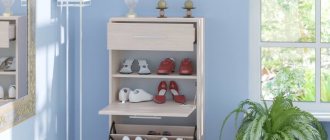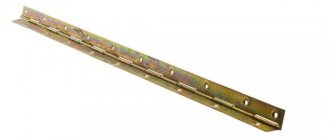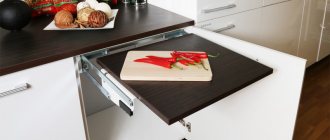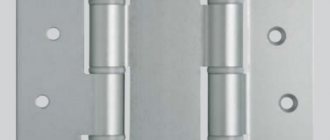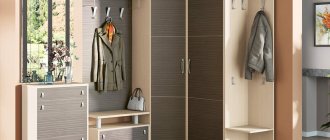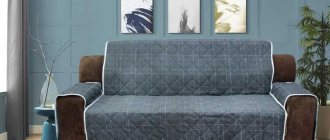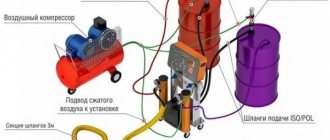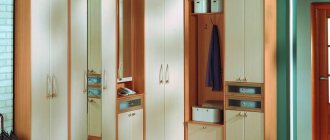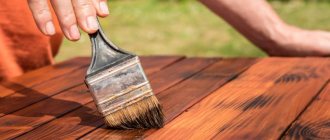Drill for confirmation: types, selection criteria, design features, technology of use
To assemble furniture, you need not only the skills and experience of a craftsman, but also high-quality fasteners.
One of the most popular methods of fixing parts is the technology using a Euroscrew. The element allows you to securely attach to the material in one operation. You just need to make a geometrically correct hole. To do this, you need a special drill for confirmat (euroscrew). Its dimensions are strictly defined. The product is unified to a single standard, so it can be easily replaced with a similar one from another manufacturer.
Additive and connection of furniture parts to furniture ties, confirmat, euroscrew
Most of the parts in cabinet furniture made of chipboard are connected using furniture ties, which are also called confirmats after the name of one of the companies that produce them. The connection with furniture ties is strong and can withstand several cycles of disassembly and assembly of furniture (usually no more than three). In furniture production, holes in parts for tie rods are made with special drilling and adding machines; at home, a drill or screwdriver is sufficient.
Standard sizes of ties are 7x50, 7x70, 5x50. The table shows the main dimensions for all standard sizes of ties:
The ties are tightened using a hex bit or manually with a special hex key. There are ties with barrels for a Phillips bit or a screwdriver, but they are much less common and usually have a standard size of 5x50 mm. After the tie is screwed into the furniture body, its head is closed with decorative plastic or self-adhesive plugs.
To connect two parts with a furniture tie, not only from chipboard, but also from any sheet material (MDF, plywood, furniture board), two holes are drilled. In the part indicated in the diagram with the letter “A” (vertical), a through hole is drilled corresponding to the diameter of the screed barrel. Accordingly, these are 7 mm and 5 mm for different types of ties. In part “B” (horizon), drill a blind hole for the threaded part of the tie. For ties 7x50 and 7x70, this is a diameter of 5 mm; a 4.5 mm drill is also suitable; a 6 mm drill will be too large and will not provide good fastening of the parts to each other. For 5x50 ties, take a 3 mm drill.
When drilling holes for tie rods, it is important to remember:
1. The depth of the hole should be equal to or slightly greater than the threaded part of the tie. If the depth is not enough, then when you start tightening the tie, it will hit a dead end and the thread will tear out all the chips from the chipboard and the parts will not connect firmly, and the head of the tie will stick out on the surface.
2. The through hole for the barrel for the screed should not be located close to the edge of the sheet. When working with 16 mm chipboard, this distance is 8 mm in the center of the drill from the edge. Otherwise, when tightening the tie, you will have a deformation of the end of the part, on which a bump will appear, formed by the chipboard compressed when the tie is tightened.
In those places where protruding heads of ties are not appropriate for aesthetic reasons, for example, a tabletop near a table or an open shelf under which there is a vertical part attached to it, eccentric ties are used.
Types of confirmations and holes for them
Externally, the Euroscrew resembles a screw, from which it fundamentally differs in the diameter and shape of the cut tooth. This design feature allows you to increase the area of contact with the body of the fastened part several times. As a result, connection reliability increases significantly.
One confirmat replaces 3-4 screws of the same length. For furniture made from chipboard, the figures are even more impressive. The middle of the sheet is the loosest part of the material. A thin screw is not able to securely fix itself. Due to its larger diameter, the Euroscrew captures harder layers of chipboard and it is no coincidence that manufacturers clearly prefer it.
Manufacturers offer a line of products with different sizes for different types of connections. Not all models can be found in the store. Some are used only for special purposes. They can be ordered or purchased at specialized retail outlets.
| Model | 5x40 | 5x50 | 7x40 | 7x50 | 7x60 | 7x70 |
| Overall length, mm | 38,5-40,0 | 48,5-50,0 | 35,5-40,0 | 48,5-50,0 | 58,5-60,0 | 68,5-70,0 |
| Cap diameter, mm | 7- 7,5 | 7- 7,5 | 9,5-10 | 9,5-10 | 9,5-10 | 9,5-10 |
| Head length, mm | 6 | 6 | 10 | 10 | 10 | 10 |
| External thread diameter, mm | 4,7-5 | 4,7-5 | 6,3-7 | 6,3-7 | 6,3-7 | 6,3-7 |
| Diameter at the bottom point of the thread, mm | 3,4 | 3,4 | 4,7 | 4,7 | 4,7 | 4,7 |
The method of twisting the confirmat depends on the shape of the head. It can be hexagonal or cross-shaped. For euroscrews of small diameter (5 mm) a 3 mm wrench is used, and for large products (7 mm) a 4 mm wrench is used.
The drill dimensions are determined in accordance with the table. Depending on the material, the hole for the thread is made either 3.5 mm or 4.5-5 mm. The confirmatory head requires a diameter of 5 mm and 7 mm, respectively, depending on the brand.
How to drill a hole for placing a confirmat
The confirmat is screwed into a previously prepared hole, so the question of how to drill such a hole is quite relevant. To do this you will need the following tools and materials:
- screwdriver or electric drill;
- bit of the appropriate size;
- drill for confirmation;
- a measuring tool, which can be a ruler (or a construction tape);
- pencil;
- awl.
To facilitate marking and maintain a strictly perpendicular position of the drill, use a template for drilling holes for confirmat
Hole dimensions for Euroscrew
For furniture assembly, Euro screws are usually used, the dimensions of which are 6.4x50 mm. To make holes for such a confirmat, the outer thread diameter of which is 6.4 mm, and the cross-sectional size of the screw body is 4.4 mm, a drill with a diameter of 4.5–5 mm is used. Drilling holes for confirmation of this type should be performed to a depth of at least 50 mm. If the diameter of the hole is larger than the specified value, then the Euroscrew simply will not hold; if it is smaller, it can tear the furniture element into which it is screwed.
The step drill is selected based on the dimensions of the specific Euroscrew model
The drill used to make holes for the confirmation must be equipped with a special working head. On the one hand, she prepares an expanded hole for the neck of the screw, on the other hand, she countersinks the place where the screw head will be placed. To place the confirmat, you can also use a regular drill, but in this case it is necessary to prepare places for the neck of the fastener and its head.
Design features of drills for confirmations
Euroscrews are used both on hardwood products and on furniture made from chipboard and LMDF. In these cases, the load on the tool is high. When choosing low-quality products, noticeable wear of the cutting edge occurs. When purchasing, you need to make sure that the confirmat drill has a Rockwell hardness of 61-64. A self-respecting manufacturer indicates this value on the packaging.
If the drill falls into the hands of a master without information about the product, then you need to look at the body of the product. Domestic manufacturers write the steel grade. Drills made from alloys R9M5 and R18 are considered the best. Among imported products, products made from HSS 4341 have excellent performance. The abbreviation stands for High-Speed Steels, that is, just like P9M5 and P18, it is high-speed steel.
It is most convenient to use a finished product, where the diameter of the drill is precisely selected for the confirmation and there is an additional cutting edge for the head, where there is no thread, and to create a chamfer for the head. The design increases productivity several times.
Three operations are performed in one pass. You can use a set of drills of the required diameter. However, for better performance it needs to be improved. The factory device has a sharper sharpening angle of the cutting edges. This makes the approach easier and more accurate.
Connecting furniture using confirmat
Share
Link
Share to other sites
- The article introduces “confirmat” furniture fasteners, and also, using the example of a drawer for a bedside table, describes the technology for assembling furniture using the above-mentioned fasteners.
A confirmat is a screw with a blunt end, which is needed to fasten wooden elements together. This screw is screwed in using a cross or hexagonal cutout in the head. More often you can find the second type. Before screwing the confirmat, you need to drill a hole.
The confirmat received its name from the German company Confirmat of the same name, operating in the 1970s. In Russia, this type of fastener, oddly enough, began to be actively used only in the early 1990s.
Confirmat is a representative of a standard furniture connection. Thanks to it, you can easily pull and tightly compress two pieces of wood, which after such a connection will never diverge.
Having studied the information described below, you, by analogy, can assemble furniture in your home with your own hands, ordering only boards cut to the required dimensions and having edges in the right places. Many companies now provide similar services, and self-assembly of furniture has long become a favorite “place” where sensible people try to save money.
Technology for assembling furniture “to confirm”.
First of all, let's get acquainted with the tools and accessories that we will need.
1) Drill with drill (photo 2-3) – the diameter of the drill is selected according to the diameter of the confirm thread. Most often it is 5mm. 2) Screwdriver (photo 4) – used for screwing the confirmat into wood. When tightening, significant resistance forces can occur, so make sure that your screwdriver is set to the maximum power setting. To work with the confirmat, a hexagon is inserted into the screwdriver (photo 5).
Hand tools and fixtures:
1) Hex key (photo 6). This key is needed in order to press the confirmat until its cap sinks into the surface of the tree. The convenience of such a wrench is that it is small in size and it is not necessary to make a full turn to tighten it, since the tool has a ratchet, the principle of operation of which is especially well known to motorists. 2) Square with clamps (photo 7). When connecting two wooden elements, the square serves as a lock that prevents the wood from moving apart, making a perfect 90-degree angle.
As already mentioned, we will be assembling a drawer for a nightstand as an example. Such drawers are also popularly called cabinets or bedside tables. Four chipboard boards will be required as prepared raw materials (photo 8). For convenience, all parts of the work will be broken down and described in stages.
We assemble the boards into the shape of a drawer. Let's look carefully at the edges. Those places where the end of the board connects with the plane of another board do not have a decorative edge. In its place there is an ordinary nondescript saw cut, which is covered either with another board or with a facade. Facade – the front side of the furniture. Having outlined what will be located where, proceed to the direct connection.
We make one of the 90-degree angles of the drawer for the bedside table. Your task is to make everything as smooth as possible. The junction of two elements should be as smooth as possible. A corner with clamps will help you cope with the task (photo 9). You need to press the sides on it alternately. If you do everything at the same time, you will not achieve evenness! Do not press too hard as this will damage the edges on the wood. When making a corner connection, first set the upper edge and only after fixing it with confirmation, the lower one. Doing everything at the same time, and at the same time smoothly, is a very difficult task!
Having fixed the two wooden elements, we begin to drill a hole for the confirmation (photo 10). We do this with a drill. Holding the wooden plank on one side with your hand, use your other hand to bring the drill to the desired point. Your goal is to drill the hole so that it goes through the center of the end of the board (Photo 11). The depth of the hole depends on the length of the confirmat. Pay attention to the photo of the drill (photo 12). It has an extension towards the base. This is necessary in order to obtain a hole into which the thickened part of the confirmat will fit. When drilling, do not immediately make a hole to the entire required depth. At first, it is drilled only until the drill thickens, after which the drill is removed from the wood at speed, and with it the chips. Only after this can you drill the hole to the end. The square with the clamp cannot be removed after drilling!
At this stage, you will need, directly, the confirmation itself (photo 13). We insert it evenly into the drilled hole (photo 14). Then we tighten it with a screwdriver with an inserted hexagon tip (photo 15). There is no need to tighten the confirmation with a screwdriver until the end (photo 16). You can do this easier and more accurately using a hex wrench (photo 17). We continue to clamp the confirmat with a hexagon until the head of the above “sinks” a little into the wood (photo 18).
We attach the second side of the drawer for the bedside table. The corner clamp can now be removed. We set the correct location of the second side by hand and fix it in this position (photo 19). With the second hand we drill a hole similar to what we just wrote about. The hole made according to the rules looks like this (photo 20). We twist it into its confirmation and that’s it, one corner out of four is assembled (photo 21-23)!
How to choose a drill?
Before you start assembling furniture, you need to prepare all the tools. Information about the Euroscrew itself will help you choose which drill to use for the confirmation. If you have a ready-made device of the right brand, then there will be no problems.
However, often in the practice of home craftsmen there is a situation when they have to work with what is available. It is strongly not recommended to use drills of a smaller diameter - for confirmations 5x40, 5x50 this size is 3.4 mm, and for products 7x40, 7x50, 7x60, 7x70 - 4.5 mm.
The fastening element does not screw into a hole that is not large enough in size and becomes jammed. If you work with furniture parts made of chipboard or LMDF, then at best they will swell, and at worst they will crack.
The head of the confirmat is measured, the part that is inside the product but does not have a thread. It may vary slightly between different manufacturers. The diameter ranges from 6.3mm to 7mm. Which confirm drill should I choose in these cases? The factory device is designed for a diameter of 7 mm.
It is universal because the size of the head does not play any role in ensuring the reliability of the connection. This part of the Euroscrew is located in the upper, pressing part. The load falls on the confirmation cap, which centers the fastener and tightens the structural elements.
A little play is sometimes even convenient. If there are minor errors, you can loosen the connection, adjust the position of the part, and tighten the screw again. Even a hole a millimeter larger than 8 mm will not impair the reliability of the fastener.
Furniture euroscrew (confirmed): optimal size, how to install
- Design features
- Features and Benefits
- Installation Rules
- Drilling and installation
Hi all! If you have ever assembled cabinet furniture purchased in a store, or were interested in it, then you probably know about such a fastening as a furniture euroscrew. He is a confirmat.
Confirmat is called one of the most popular furniture fastenings in our time, which is widely used in assembling cabinet-type furniture. These fasteners became widespread back in the 90s of the last century, and since then they have not lost their relevance.
In everyday life, you often come across such names as furniture euroscrew, euroscrew, eurok, etc. But in reality, it is correct to call this element nothing more than a single-element tie. This designation seemed too complicated and lengthy to the people. Therefore, all sorts of alternative designations appeared.
As for the name Confirmat, it comes purely from the name of the Confirmat trademark. It belongs to the Hafele company from Germany and was used specifically in the production of new types of fasteners.
Design features
To understand even better what it is and what furniture confirmations look like, you can look at the photo and get acquainted with the design features.
Before us is a screw that has a countersunk head with a hole (slots) for a hexagon and a tetrahedron. With its help, the Euroscrew is tightened and unscrewed when assembling and disassembling furniture. This combination of splines allows you to simultaneously use a hexagon and a tetrahedron when fastening furniture elements.
The rod has a blunt end, and a wide pitch thread is used on the working surface. The lower turns of the existing thread are used to cut threads in pre-prepared holes. Because of this, their shape is conical and there are sharp serrations.
Under the head itself there is a smooth and fairly wide surface, devoid of threads. That is, the head, cap and threaded part can be distinguished structurally.
All confirmations have a zinc, nickel or brass protective coating. The euroscrews themselves are made on the basis of high-quality high-carbon steel. This provides the structure with a high level of elasticity. As a result, the Euroscrew bends but does not break. Plasticity is beneficial when removing screws in situations where installation was carried out incorrectly.
Confirmats are widely used when joining furniture components made of wood, chipboard, MDF, etc.
There are several standard sizes of these elements. Namely:
- 5x40;
- 5x50;
- 6x50;
- 6.3x40;
- 6.3x50;
- 7x40;
- 7x50;
- 7x70.
But these are not all the sizes that are available for sale. The price largely depends on the size characteristics.
At the same time, you can find products with dimensions of 6.3x13, 4x13, etc. The most popular and common sizes are Euro screws with a length of 50-70 millimeters and a thread diameter of 7 mm.
Features and Benefits
In fact, confirmats are the same screws, but have a more massive working body. The thread has a wide threaded pitch, the head is longer, and a secret special design is hidden in the head.
Confirmats can use different splines, which allows the use of different tools. In one situation you will need a confirmation bit, in another an ordinary figured screwdriver, in a third a hexagon or tetrahedron. If we compare it with other hardware, here we have a round section and a straight cut.
The most practical option is the use of confirmations adapted for hexagons. They are the most reliable and easy to use. When the parts are connected to each other, you can use a hex bit, a screwdriver or a special wrench for additional tightening.
Compared to the same screwdriver fasteners, they cannot provide the same level of strength. Therefore, furniture connected by confirmations turns out to be more stable and does not become loose over time.
All confirmations can be used:
- for array;
- chipboard;
- for wood;
- plywood.
Using a Euroscrew you can replace traditional corners. This is due to the ability of the confirmat to withstand bending loads. Therefore, confirmations have become widespread not only as fastening fittings, but also as frame-forming elements.
To disguise fasteners, plastic plugs or special stickers are used. They are made to match the color of the furniture itself or in a similar shade. This ensures the creation of a finished look for furniture products, since confirmations are invisible against the general background.
Installation Rules
Many who come across confirmations for the first time have a logical question regarding which holes to drill for the Euroscrew being used and how this procedure is generally performed.
There shouldn’t be any problems with how to drill holes if you have previously worked with a drill and understand the principle of its operation.
Before installing the confirmation in the furniture body, it is necessary to make the appropriate markings. To apply it you will need a jig or a template. With their help, you can significantly speed up the work and also achieve a high level of accuracy. If you are doing simple markings, you will not need a jig (template).
For proper installation of the confirmat, it is recommended to find out in advance about the material of the furniture itself, as well as about the design features of the euroscrew. A total of 3 holes are needed:
- under the threaded screw part;
- for the smooth part of the euro head;
- under the hat.
A drill of the appropriate diameter is used for each hole. It is the time required to create several holes that makes you spend much more time assembling furniture.
But there is a solution. It is presented in the form of a special drill, which is intended specifically for confirmations. Finding it in Leroy Merlin or in any other furniture fittings store will not be difficult. The peculiarity of a special drill is that it allows you to prepare 3 different holes simultaneously in one go. This is due to the design of the drill itself.
Drilling and installation
We will step by step consider the procedure for drilling a hole and then installing a confirmat into it.
To assemble furniture using Euroscrews, you need to prepare special holes. The process involves performing the following steps:
- First, a hole is drilled for the tie (confirmation). Drills with a diameter of 4 to 7 millimeters are often used here;
- Thanks to a stepped cutter or just a special drill for confirmation, the procedure can be significantly simplified;
- The cutter is fixed on the drill. This makes it possible to correctly form a hole in two components simultaneously;
- For the threaded part of the confirmation, the diameter should be 5 millimeters, and the diameter of the hole for the head itself is already 7 millimeters;
- On the first furniture element, a hole is made of the through type, since the smooth part of the special head and the cap itself will be located there;
- In the second part, a blind hole is made, where an internal thread is formed by drilling the threaded part of the Euroscrew in the end part;
- To ensure the most accurate connection, furniture elements can be fixed using machines, furniture vices and other devices. This prevents possible shifts.
Device Manufacturers
The correct name for a fastener is a single-piece fastener. This term is used to fill in data when ordering and to draw up reporting documentation at specialized enterprises. In everyday life, it is more common to hear other names, for example, “euroscrew”, “euroscrew”.
The word confirmat appeared thanks to the trade name of the Hafele company from Germany Confirmat. This category of fasteners appeared back in the 70s of the last century, but they gained real popularity in the 90s. Since then, products have been produced by many domestic and foreign manufacturers, including the Hafele company, which is successfully operating to this day.
The demand for products in large quantities is covered by Russian enterprises. These are ZAO Izhevsk Furniture Accessories Plant FMS, JSC Metallist and many others. Products from Chinese manufacturers are widely represented on the market, the quality of which is not always at the proper level. But one of the oldest enterprises in China, Haining Yicheng Hardware Co., Ltd. you can trust.
Drilling rules
Reliable and accurate fastening of furniture parts depends on following the step-by-step instructions. The drilling procedure and rules are as follows:
- Check whether the confirmat drill matches the available Euroscrews.
- Make precise markings on the parts, taking into account allowances.
- Fix one or both workpieces in the desired position.
- Drill a hole, controlling the position of the tool.
A drilling device will be a good helper in your work. Similar universal products are available for sale, but you can make them yourself. Designs vary, from simple templates to devices with guide bushings for precise drill orientation.
It is very convenient to use universal devices for adding furniture parts. They are used to make preliminary holes of smaller diameter.
They have a certain thickness and a standard confirmat drill, the dimensions of which are not designed for this operation, will not work. They are given finishing treatment. All the same, the end result is a gain in time, and most importantly in the accuracy of the holes.
Types of furniture ties
In this lesson we will talk about furniture ties - their purpose, main types, and also teach how to install a dowel and confirmat.
Although you can use the most ordinary fasteners (for example, self-tapping screws) when assembling furniture, it is much more convenient to use specially designed ties that take into account the characteristics of furniture materials and allow you to connect its parts quickly and reliably!
Confirmat
The most common type of tie is the confirmat, also known as “euroscrew”, “euroscrew” and “screw tie”. It is intended for connecting parts based on chipboard, plywood, solid wood, MDF, etc. Confirmat is a screw with a countersunk head and a blunt end. It is distinguished by its quick and easy installation, which does not require special skills or equipment. To install and adjust it, you only need a hex wrench
The name of this screed comes from the name of the German trademark “Confirmat”, under which it was produced by Häfele. Although Soviet furniture makers became acquainted with the confirmat back in 1973 at the Lesdrevmash exhibition, it began to be used in domestic furniture production only in the 90s.
The disadvantage of this type of screed is that when installing it, we violate the integrity of the front surface. You have to drill a hole in it and hide it with a plug. When reinstalling the screed in chipboard, there is a very high risk of damaging the material.
Depending on the purpose, the confirmat is available in different lengths and diameters. The most common size: 7x50. Its cost in the HASS online store is from 1.50 rubles. a piece. The cost of the plug is from 10 kopecks per piece.
Installation of confirmat
For clarity, let’s connect two panels using 7x50 ties. Measure the distance from the edge and apply markings.
Mark the locations of future holes using a sharp awl.
Let's make a hole for the screed according to the diameter of its smooth surface: 7 mm. For a threaded surface, a hole with a smaller diameter is used than for a smooth surface. In this case, 5 mm.
In order for the head to fit tightly, it is necessary to countersink. For this we use a countersink of the appropriate diameter.
After making sure that our hole fits perfectly under the tie, we can tighten it with a hexagon.
To hide the head, use a plug of the desired color.
Intersectional screed
To connect furniture sections, for example, two adjacent cabinets, an intersection tie is used. It consists of a screw and a threaded bushing. As a rule, 3-4 ties are used for one connection. Its cost in the HASS online store is from 55 kopecks per piece.
Shelf holder
Shelf holders are used to install shelves. We have already mentioned them in the lesson “Pumping Up Your Kitchen Cabinet”. There are shelf holders for chipboard (from 1 rub. per piece in the HASS online store).
And glass shelf holders with silicone suction cups (from 4 rubles per piece in the HASS online store).
.
They are installed in specially prepared holes.
Dowel
To fix and connect dismountable furniture, a dowel, also known as a dowel, is used. In common parlance, some call it “chopik”. For dismountable connections, it plays the role of a guide and is used in combination with the confirmat. If they are not dismountable, they are placed on glue. The cost of a dowel in the HASS online store is from 1.5 rubles. a piece.
Furniture ties: laying out the essence
Assembling furniture is a non-trivial task when it comes to non-standard and interesting solutions. But there are clear rules for how the elements are attached to each other. At a certain point, dowels were common, and they are still used until that time. There are other solutions for fixation, which will be discussed in the article.
Purpose
When assembling a furniture product, the location of the connected parts of the structure must be checked so that its integrity is not compromised during operation. This is what a furniture tie is intended for - a fastener that makes it possible to tightly and firmly connect structural elements located in a certain position (most often at a right angle) relative to each other. If previously furniture was assembled mainly using screws and self-tapping screws, now different types of ties are used for this.
This replacement is due to three reasons:
- Increasing the aesthetics of furniture, thanks to the use of ties, the fastening of parts becomes invisible;
- Each disassembly of furniture assembled with screws reduces reliability;
- Sometimes the use of conventional fasteners is simply impossible for structural reasons.
And finally, the use of furniture ties allows for quick and durable assembly of the product.
Features of furniture euroscrew, main scope of application
A popular type of fastening - furniture euro screw - is known in various variations: con. It got its name from the Confirmat trademark, under which the German company produced fasteners. The main area of use of Euroscrews is the assembly of furniture structures.
Advantages and disadvantages
Advantages of using a furniture euroscrew:
- Low cost;
- Fast and reliable connection of parts;
- Possibility of fastening different types of parts;
- High withstand bending and tearing loads;
- Easy to install, does not require additional special devices;
- Does not destroy mounting holes, thus interior items can be assembled and disassembled.
The disadvantages of Euroscrews include the fact that they are not hidden fasteners. In order for the products to have a neat appearance, they have to be hidden using special plugs or plastic covers. Another disadvantage of using fasteners is the limitation of furniture assembly. The Euroscrew does not allow the process to be carried out more than 3-4 times. This is due to the fact that with frequent disassembly of furniture, the threads can wear out or break off.
Dimensions and materials of manufacture
The sizes of confirmations are as follows: 5x40, 5x50, 6.3x40, 6.3x50, 7x40, 7x50, 7x60, 7x70 mm. The most common are single-element ties with a thread diameter of 7 mm and a length of 50-70 mm.
| Designation | Europrop 7x40 | Europrop 7x50 | Europrop 7x60 | Europrop 7x70 |
| Head height, mm | 10 | 10 | 10 | 10 |
| Length, mm | 35,5-40 | 48,5-50 | 58,5-60 | 68,5-70 |
| Key size, mm | 4,02-4,12 | 4,02 | 4,12 | 4,02 |
| Flange diameter, mm | 9,5-10 | 9,5 | 10 | 9,5 |
Fasteners are made from high quality materials, often carbon steel. They are coated to prevent corrosion. The coatings are:
- Brass;
- Nickel;
- Zinc.
Euroscrews made of aluminum alloy are quite flexible; they do not break during furniture assembly. Thanks to these properties, the fastener can bend; if installed correctly, it can also be easily removed.
Design Features
Euroscrews for connecting furniture parts are a single-element tie. In essence, they are the same screws, only their body is more massive. The confirmation threads have a wide pitch, the head is elongated, and the head has a hidden design. The slots for the tool are different. Some are suitable for a curved screwdriver, others for a hex key. Unlike other hardware, the ends of Euroscrews have a straight cut with a round cross-section.
Using a confirmed hexagon is considered more practical and reliable. After connecting the parts together, you can further tighten them using a hex bit, screwdriver, drill or special wrench. Fasteners for a Phillips screwdriver cannot provide such secure fastening, since it will not be possible to tighten the parts tightly. Subsequently, this will affect the strength of the structure; it may become loose and lose stability.
Confirmats are used to connect parts made from:
- MDF;
- chipboard;
- wood;
- plywood.
Euroscrews can replace standard angles. They easily withstand all bending loads. This feature allows the confirmata to perform not only a fastening function, but also a frame-forming function. To disguise the fasteners, plastic plugs (diameter 12 mm) are used, similar to the general color of the interior items. They are made of plastic. There are also special round stickers on sale. The thickness of the plugs does not exceed 0.4 mm. They can be chosen in the same shade as the furniture itself. Interior items take on a finished look, and the Euroscrews on them become invisible. Self-adhesive elements are more common; they are convenient and easy to use.
Installation rules
Before installing the fastener, you must make the appropriate markings. For these purposes, there are special conductors or templates. They significantly speed up the process and make the work more accurate. Conductors eliminate marking errors and are used mainly for large volumes of work. If you need simple markup, you can do without templates. If all stages of the work are done correctly, connecting parts in this way will be the most reliable, durable and at the same time convenient.
In order to correctly install the confirmat, you need to know some nuances regarding the material of furniture and the design features of the fastening element. It is necessary to drill three holes: for the threaded part, for the smooth head and for the cap. For each of them, drills of different diameters are selected. Drilling multiple holes significantly increases the time required to connect elements. In this case, a special drill designed specifically for the Euroscrew comes to the rescue. It is manufactured in such a way that a hole is drilled at one time to fit all three parts of a single-piece screed.
- The first step is to drill a hole for a single-element screed. To do this, use a drill with a diameter of 4 mm to 7 mm;
- Step cutters will make it easier to make holes intended for placing the head in it. The cutters are attached to the drill. Using this particular method facilitates the simultaneous formation of the correct hole in two elements at once. The diameter of the hole for the Euroscrew, or more precisely for the threaded part, is 5 mm, for the head - 7 mm;
- A through hole is made on the first part where the smooth head and Euroscrew head will be placed;
- A blind hole is drilled in another part, in which an internal thread is formed by drilling the threaded part of the confirmat at the end;
- For a more precise connection and to prevent shifting, the elements are firmly fixed with special devices (furniture vices, clamping machines, etc.).
It is important to use tools that can operate at high speeds. They will ensure that the most accurate and correct holes are drilled.
Euroscrew is a reliable modern hardware that greatly simplifies the process of assembling hull structures. At the same time, you can abandon unsightly corners and other usual fasteners. Correct installation ensures the stability and durability of furniture elements and extends their service life.
Types of fasteners
Furniture ties can be used individually or in combination with others. Some furniture items are designed for special occasions. It makes sense to consider the features of each and the principle of its installation.
You might be interested in:
- Online furniture store Alanamebel.ru
- Industrial mountaineering and reasons to choose it
- What to do if you need to get a loan?
- Single-leaf plastic windows
- What is the difference between artificial and natural rattan furniture?
- Diesel generator
- Projects of attic houses
- Principles for creating public transport stops
Confirmat
The most common type of fastener is confirmat.
At the same time the easiest to use. With its help, assembling furniture is easier and faster than using other types of furniture screed. Especially if during assembly you have to drill holes for fasteners yourself. Using a confirmat, two parts are connected at an angle of 90 degrees. Fig.1.
Confirmat - used to connect parts at an angle of 90 degrees. The two parts are connected with 2 confirmed screws. The confirmat is installed at a distance of 3-7 cm from the end of the parts to be connected. To install 1 confirmation screw, you must first drill 2 holes in the parts to be joined: in the end of the first part for threads (drill diameter 5 mm), in the second part for the head (drill diameter 6 mm).
In order to tighten the two parts, you need to drill two holes. One in one part, with a diameter equal to the diameter of the confirmator head, the other, at the end of the second part, with a smaller diameter equal to the diameter of the threaded part.
As a rule, drills with a diameter of 6 and 5 mm are used for this, respectively. However, there is a combination drill available for drilling holes at the same time. It is very comfortable. There is no need to constantly rearrange drill bits or use two drills at the same time.
Fig.2.
Drill for confirmation. Allows you to make a hole for 1 confirmat screw in two parts at once, and also forms a recess for the confirmat head. Increases the speed of furniture assembly by at least 50%.
Confirmat is a universal fastener, but it has some disadvantages and application features.
Confirmat should be used simultaneously with the use of dowels.
A dowel is a wooden rod with a diameter of 6-8 mm and a length of 20-30 mm (in the photo below, next to the confirmation). The dowel acts as a guide and does not allow parts to move during tightening. Fig.3.
Connecting the parts using a dowel with a diameter of 6-8 mm and a confirmat. This joining method is used in factory furniture, for example furniture from IKEA. Provides high accuracy of joining parts.
Despite the fact that furniture assembled using confiramate can be assembled or disassembled, furniture made from laminated chipboard does not tolerate this very well. As a rule, after one disassembly, the furniture screed no longer holds well.
The confirmation should be wrapped carefully.
The best option is by hand or with a screwdriver at low speed. Otherwise, the confirmation thread turns into a drill, which breaks the hole. Fig.4.
Tightening of parts with confirmation. The tie is performed with a hand wrench or a screwdriver with a low rotation speed of the chuck. The screwdriver must have the correct tightening torque to prevent thread stripping.
In order to recess the head into the body of the furniture part, you should use a wrench and do it carefully, otherwise there is a possibility of the thread breaking. Sometimes it is necessary to pre-calculate.
Con fasteners. Those. Unlike other types of fasteners, it remains visible, so it is necessary to use special plugs or stickers to hide the fasteners.
Fig.5.
Plastic plugs (linings). Used to hide the confirmat's cap. They are attached to the confirmation cap in the key groove and are held in place by a specially shaped core. Available in various colors.
Fig.6.
Self-adhesive overlays for confirmat. Designed to hide the cap. They have a wide range of colors, completely identical to chipboard panels. Almost invisible on furniture.
How to choose the right one
To select the correct furniture screw, you should consider what material it will be installed in. The choice of head will depend on the force applied and the space available when screwing. It is also important to choose not only the type of head, but also the pattern for the tool used.
With proper selection of bits, a strong grip of the fastening element with the screwing tool is ensured. Only in this case, the screws smoothly and evenly enter wooden boards, drywall, laminated chipboard, MDF.
Some important nuances that will help buyers of fasteners much better navigate their diversity, as well as make the right choice:
- color - screws from the same batch must be in the same color scheme. This indicates that all products have undergone the same processing under similar conditions, and also have the appropriate strength and corrosion resistance;
- parameter - the sizes of one batch of products should not be visually different from each other, and also comply with standards;
- pitch - the load between the threads should be distributed evenly;
- hole - the slot must be clear, symmetrical, and be deep enough;
- marking - the standard designation of screws - is a number in which the first number is the size of the thread diameter, the second is the length of the product from its very head to the sharp tip.
If furniture screws meet the specified criteria, then you can be confident in the quality of the furniture fasteners, which will not break during installation.
In order to efficiently assemble and install furniture elements, you need to use such a convenient, accessible assistant in fastening work as a screw. This type of furniture screed will not only simplify the assembly and installation procedure, but will also be invisible after the installation process is completed, thanks to its unique structure. All structures and foundations fixed with such fasteners will retain their shape, appearance, and properties for a long time.
